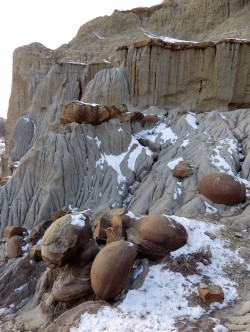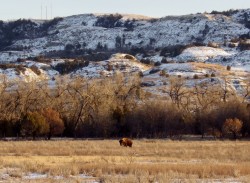Culture | January 28th, 2016

Sites to see in these locales are the top five destinations as chosen by the New York Times in its article “52 Places to Go in 2016.” Theodore Roosevelt National Park of western North Dakota took the No. 5 spot, selected for its embodiment of conservation that President Theodore Roosevelt championed.
However, the national park was the 107th most visited site in 2014 of the National Park Service’s 367 sites. Just under 560,000 people visited the park that year, out of 2014’s 68 million visitors to national parks.
Split into three separate units, Theodore Roosevelt National Park conserves over 110 square miles of North Dakota’s badlands in a region dominated by Bakken oil activity. The park’s North Unit, 15 miles south of Watford City, is generally a quiet place at any time of year, particularly winter.
Cannonball concretions
These geologic formations are formed from groundwater containing natural chemicals moving through sediments and rock after deposition. A piece of organic matter like a fish scale or leaf causes a small chemical change, causing the groundwater’s dissolved ions to emerge and form concretions.
Concretions can be any shape and size, and the ones in the North Unit are spherically shaped and commonly called cannonballs.
“Some are not spherical, but they are probably influenced by odd shapes of organic matter when they start forming, or several bits and pieces of organic matter near each other,” said Kenneth Lepper, North Dakota State geology professor. “Some concretions can grow quite large. About … three feet in diameter is the largest I have seen in the North Dakota badlands, but in Ohio I have seen … six feet diameter concretions. “

Wildlife
The American bison is North America’s largest land animal, with some bison reaching a weight of over 2,000 pounds. Bison are what drew Roosevelt to the badlands of Dakota Territory in 1883, and he shot and killed one of the few remaining shaggy giants in the fall of that year.
Theodore Roosevelt National Park reintroduced bison to its badlands in the 1950s and ‘60s. Up to 700 bison roam the North and South units.
Mule deer are also native to North Dakota’s badlands and can often be seen at dusk and dawn and along the North Unit’s scenic road.

Layers
North Dakota’s badlands are colorful and many layered in places of its erosive landscape.
“The rock layers are all sedimentary,” Lepper said. “They have different degrees of cementation, so some layers are harder than others. That’s why we get differences in erosion and the ‘badlands’ topography.”
While its layers of sedimentary rock were laid down as late as the Cretaceous Period 65 million years ago, the badlands as we know them were formed just 600,000 years ago. A diverting glacier caused the Little Missouri River to flow more eastward, stripping away the soft rock and sediment into the colorful land we see today.

Little Missouri River
The shallow and sinuous Little Missouri River winds north and east through western North Dakota, from its headwaters in northeast Wyoming. Emptying into Lake Sakakawea, the Little Missouri River flows for some distance through the North Unit, where visitors can view the river from high vantage points such as River Bend Overlook and Oxbow Overlook.
Bill Sewall, a manager for Roosevelt’s Elkhorn Ranch, said the river was “the meanest apology for a frog-pond I ever saw.”
Roosevelt’s Elkhorn Ranch was built right on the Little Missouri, 35 miles north of Medora, N.D. Though the house is long gone, its cornerstones and solitude remain.
The river freezes solid in many places, and animals leave a variety of tracks in the powdery snow.

December 18th 2025
October 20th 2025
October 15th 2025
September 16th 2025
July 29th 2025
_(1)_(1)_(1)__293px-wide.jpg)
__293px-wide.jpg)
_(1)__293px-wide.jpg)
__293px-wide.jpg)

_(1)__293px-wide.jpg)